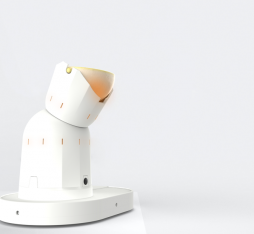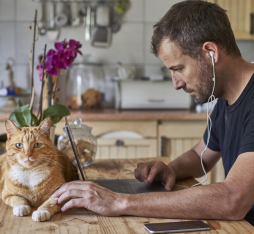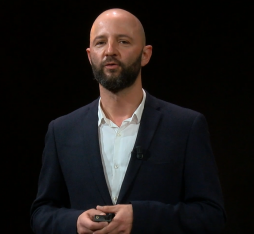Orange has ambitious CSR targets, including a Net Zero Carbon by 2040 target.
As a result, research was conducted to investigate how we can educate and help everybody to take action on their energy footprint, while simplifying their everyday actions.
This article sets out possible solutions that can be implemented at home. For example, it describes the Orange cube, a real, tangible object that is energy self-sufficient and easy for households to use.
I turn off the light when I leave home, but what about the Wi-Fi? How Orange can help households to control their carbon footprint
The chosen application for this is Wi-Fi, a technology that is now very widely used and consumes energy, meaning it is a source of substantial savings.
Who turns off the lights before leaving home? Everybody.
Who turns off their Wi-Fi? Nobody! Well, almost nobody…
However, Wi-Fi consumes around 2 to 4 watts. That’s the equivalent of an LED bulb, which everyone thinks to turn off.
How can we change this? And why should we change this?
If we look at Orange subscribers in France (~11M Liveboxes), turning off the Wi-Fi for 10 hours per day per household would save about 64 GWh/year, the equivalent of the annual consumption of a city with 40,000 inhabitants. The savings might seem small per household, but this adds up quickly when multiplied on a larger scale.
Another surprising figure: for nearly 500,000 Liveboxes, Wi-Fi has never been used but has always been left on!
Different solutions have been put forward to allow the Wi-Fi to be turned off as much as possible. For example, turning it off as soon as it stops being used and turning it back on when needed. All of this must happen without complicating the user experience, given that simplicity will be the key to operational efficiency.
Why doesn’t everyone turn off their Wi-Fi when it’s not in use? For now, let’s forget the parents of young teens who are probably already used to programming their Wi-Fi to come on for certain periods of time.
For other users, who make up the majority, responses can be categorized as follows:
- Forgetting: Put simply, you have to think about it and you have to be aware that it has a significant impact.
- It’s too complicated: Even though it may seem relatively simple to some, there can be some obstacles:
- My Livebox is in a closet, in the basement or is difficult to access.
- The app designed to control it can sometimes seem too complicated, as you must make an effort to learn to use it.
- The fear of “breaking everything”: It works, so it’s best to not touch anything.
The proposed solutions come from several Orange research programs, and are integrated into the Home’in platform, household middleware and innovation accelerator. Home’in is explained in other articles on the Research Blog: https://hellofuture.orange.com/en/sensitive-home-built-rebuilt-homein-platform/ and https://hellofuture.orange.com/en/home-in-the-future-the-home-of-tomorrow-will-be-sensitive/.
Thanks to the Liveboxes in our customers’ homes, the algorithms proposed by the AI Data teams can predict Wi-Fi usage for a home, by day and for each time slot.
Figure 1: Forecast Wi-Fi usage for a household, over a week
A non-use forecast therefore informs the platform that Wi-Fi is not usually used during a certain time slot, so it makes the decision to turn the Wi-Fi off. Similarly, for a use forecast, the Wi-Fi is then automatically turned on.
Thanks to these forecasts, those in the household don’t have to do anything, as the Wi-Fi is turned on/off based on their habits.
However, by definition, these forecasts are only forecasts and actual usage may differ.
Let’s take an example.
I am working from home as usual, therefore the forecast is for “in use” and my Wi-Fi is turned on. But I have to go out at the last minute to do some shopping, meaning the forecast is still for “in use” while there is no one at home.
Thanks to its presence detection, the Home’in platform knows that there is no one at home anymore. It will therefore automatically turn off the Wi-Fi, despite the use forecast. As a result, it is possible to be more precise than simple forecasting, by taking into account the inhabitant’s presence at home.
| Forecast | Presence | Wi-Fi |
| In use | Yes | On |
| In use | No | Off |
| Not in use | Yes | Off |
| Not in use | No | Off |
Figure 2: Possible combinations of forecast and actual presence
However, we now often have connected objects in our homes that can use Wi-Fi.
Should we permanently leave the Wi-Fi on for these objects?
Using low-power radio protocols, such as or , allows Wi-Fi to be used on demand.
In our previous example, while I was out, a delivery person came to my home. The platform plays the role of orchestrator in the house. So when the doorbell rings, which is connected via Thread or BLE, the platform then requests the Wi-Fi to start up. This means the Wi-Fi camera can record a video that will be sent to me on my mobile.
The Wi-Fi is then turned off and it will only have been on for the necessary amount of time.
The platform’s role as orchestrator makes it possible to manage household energy flows according to the inhabitant’s needs, allowing energy consumption to be optimized as much as possible.
It is also possible to manage devices that permanently use Wi-Fi, such as a security camera.
Liveboxes offer several . These different frequency bands can be managed to adapt to the uses of each object.
For example, for an alarm system that uses Wi-Fi equipment, the 2.4 GHz frequency band can be used, making it possible to switch off only the 5 and 6 GHz bands, and still save energy.
There are therefore different solutions, all based on the principle of automating the action of turning the Wi-Fi on/off and aligning this as closely as possible to the actual household needs.
However, it is likely that some uses won’t be able to be automated, and in any case, it is still essential for the user to be able to manage the Wi-Fi themselves.
This is why it seems important to make the notion of Wi-Fi tangible, as it is often viewed as abstract by default.
The solution, which came from design-oriented research, focused on a simple object: a cube. With the simple action of shaking the cube, this object can turn your Wi-Fi on or off.

Thanks to this tangible, visible object, household members will be reminded of their Wi-Fi, and in the same way that they think of turning off the light when leaving their home, they can think of turning off the Wi-Fi.
This object is energy self-sufficient, thanks to the use of solar panels. Admittedly, this is an additional object to be manufactured and is therefore not energy neutral. However, this object’s energy footprint can be controlled through the use of an eco-design, such as using sustainable materials, promoting local manufacturing, etc.
The cube has other features thanks to various built-in sensors (accelerometer, motion detection, temperature, etc.), allowing us to imagine many other uses for it.
With one simple movement, the user can control their Orange TV and set-top box, for example, turning it on/off, controlling the volume, etc.
This type of object is an interesting way to simplify the user experience.
In conclusion, integrating different technologies from Orange research has allowed us to produce several solutions that make it possible to move toward more eco-friendly behavior, closer to actual usage. There is still room for further improvement, such as integrating location data, sound recognition, environmental data analysis, etc.
The energy savings, estimated at 64 GWh/year, could be multiplied by turning our attention to the TV set-top box or any other devices left on standby.
Remember to turn off the Wi-Fi, just as you turn off the light. By making this simple action a habit, everyone can benefit.
Read more :
- Sound recognition: Katell Peron, Head of the Cyber-Physical Interactions Research Program
Sound recognition — Work’in the future (orange.com)
- Environmental data capture and analysis: Matthieu Liewig, Head of the Cyber-Physical Data Processing Research Program
Home Sensor — Work’in the future (orange.com)
- Usage forecasts: Olivier Jamot, Data@Home
Putting AI and data at the heart of our innovation model — Work’in the future (orange.com)
- Zero-energy computing cube: David Excoffier, Head of the Ambient Computing Research Program
The Orange cube — Work’in the future
- Orchestration of energy flows; Jean Philippe Javaudin, Head of the Local Networks Research Program
A device that triggers Wi-Fi activation — Work’in the future (orange.com)
Low-power radio protocol, now widely used by IoT objects. BLE consumes less energy than Bluetooth, which consumes less than Wi-Fi.
Wi-Fi frequency bands (2.4, 5 and 6 GHz)
Radio frequency bands offered by carrier equipment (for example, Orange’s Livebox), differentiated by their capabilities (throughput, range, stability)










